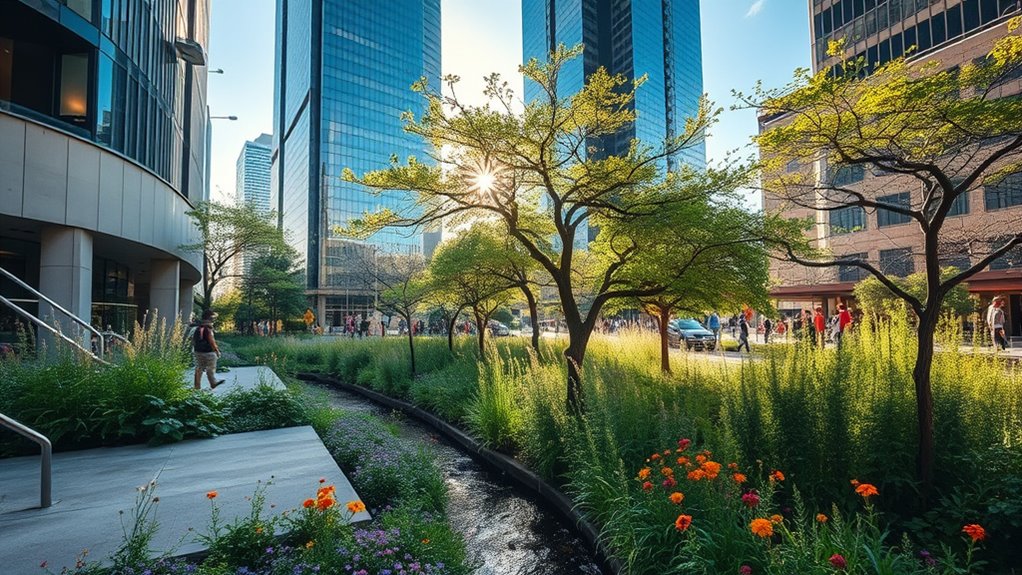Urban rewilding helps you reconnect with nature by transforming city areas into vibrant habitats for people and wildlife. It involves creating green corridors, parks, and sustainable infrastructure that support biodiversity, improve air quality, and enhance resilience to climate change. By embracing these practices, cities become healthier and more vibrant places to live. If you keep exploring, you’ll discover how these efforts can truly reshape urban spaces into thriving ecosystems.
Key Takeaways
- Urban rewilding restores natural habitats and connects green spaces to support biodiversity and ecological resilience.
- Wildlife corridors facilitate animal movement and reduce habitat fragmentation within cities.
- Green infrastructure elements like parks and rain gardens improve environmental quality and provide recreational spaces.
- Promoting native plants and community involvement enhances conservation efforts and urban biodiversity.
- Rewilding transforms cities into sustainable, resilient ecosystems balancing human needs and wildlife habitats.

Have you ever wondered how cities can become greener and more livable? The answer lies in urban rewilding, a process that restores natural habitats and reconnects urban areas with the wild. It’s about transforming concrete jungles into vibrant ecosystems that support both people and wildlife. One key strategy is creating wildlife corridors—strips of natural landscape that link isolated green spaces. These corridors allow animals to move freely between parks, rivers, and other habitats, reducing the risks of inbreeding and ensuring healthy populations. By designing cities with wildlife corridors in mind, you help foster biodiversity and make urban environments more resilient to climate change. Promoting green infrastructure is essential for creating sustainable and interconnected urban ecosystems. Additionally, integrating native plants and wildlife-friendly landscaping can further support local species and enhance ecological networks. Building awareness about biodiversity conservation encourages community involvement and long-term sustainability efforts.
Implementing green infrastructure plays a significant role in this transformation. Green infrastructure includes parks, green roofs, permeable pavements, and rain gardens that manage stormwater, improve air quality, and provide habitats for various species. When integrated thoughtfully into city planning, green infrastructure acts as the backbone of urban rewilding. It creates continuous green networks that not only support wildlife movement but also offer residents natural sanctuaries for recreation and relaxation. These green corridors and networks serve as vital ecological linkages, connecting fragmented habitats and enabling species to adapt to urban environments. Imagine walking through a city where lush trees and native plants soften the urban landscape, offering shade and cleaner air while serving as essential habitats for birds, insects, and small mammals. This isn’t just an ideal; it’s a practical way to enhance urban life.
You can be part of this change by advocating for and supporting projects that prioritize green infrastructure and wildlife corridors. For example, city planners and developers are increasingly recognizing the importance of incorporating native plants and creating green pathways that connect different parts of the city. These efforts make it easier for wildlife to thrive amidst urban development, reducing human-wildlife conflict and fostering coexistence. Plus, green infrastructure benefits you directly. It cools down neighborhoods during heatwaves, reduces noise pollution, and improves mental health by providing access to natural settings.
Through urban rewilding, you’re helping cities become more sustainable and resilient. Rather than fighting against nature, you’re working with it to create a balanced ecosystem where both humans and wildlife can flourish. It’s about reimagining urban spaces as living systems that support biodiversity, improve quality of life, and prepare cities for the environmental challenges of the future. When you understand the importance of wildlife corridors and green infrastructure, you become an active participant in shaping cities that are not only functional but also thriving, vibrant places where nature and urban life coexist harmoniously.
Frequently Asked Questions
How Does Urban Rewilding Impact Local Climate Change Efforts?
Urban rewilding helps you combat climate change by enhancing carbon sequestration, which reduces greenhouse gases in the atmosphere. It also cools city environments, mitigating urban heat islands and lowering energy use. When you support rewilding projects, you’re making cities more resilient, promoting biodiversity, and contributing to local climate efforts. This natural approach complements technological solutions, making your community healthier and more sustainable for future generations.
What Are the Economic Benefits of Urban Rewilding Projects?
Think of urban rewilding as planting seeds for economic growth. You’ll see green job creation flourish as communities embrace sustainable projects. Property values tend to increase with greener, more attractive surroundings, attracting new residents and businesses. These projects can boost local economies by reducing energy costs and drawing tourism. Overall, urban rewilding offers a win-win, turning cityscapes into vibrant hubs that grow wealth and opportunity for everyone.
How Can Residents Actively Participate in Urban Rewilding Initiatives?
You can actively participate in urban rewilding by engaging in community involvement and volunteer opportunities. Join local groups or initiatives focused on planting native species, creating green spaces, or removing invasive plants. Attend workshops or events to learn more about rewilding efforts. Your hands-on involvement helps restore ecosystems, encourages biodiversity, and creates healthier, more vibrant urban environments for everyone to enjoy.
Are There Any Potential Risks or Downsides to Urban Rewilding?
You might wonder if urban rewilding has risks. While it helps bring nature back, you should be aware of wildlife conflicts, where animals might venture into human spaces, causing issues. Liability concerns also arise if rewilded areas lead to accidents or injuries. By planning carefully and managing these risks, you can enjoy the benefits of urban rewilding while minimizing potential downsides, creating a safer, greener city for everyone.
How Does Urban Rewilding Influence Mental Health and Community Well-Being?
Imagine discovering a new green space right in your neighborhood—that’s how urban rewilding influences your mental health. It boosts community well-being by providing areas for relaxation and social interaction. Green space naturally reduces stress, helping you feel calmer and more connected. When cities embrace rewilding, you benefit from improved mental health, stronger community bonds, and a sense of harmony with nature, making urban life more vibrant and resilient.
Conclusion
As you walk through a city reborn with rewilded spaces, imagine the trees as quiet guardians and the birds as soaring messengers. These green patches become your city’s beating heart, symbolizing hope and renewal. By embracing urban rewilding, you help restore nature’s balance amidst concrete, turning your environment into a sanctuary where life flourishes anew. The city is no longer just a place to live — it’s a thriving, breathing symbol of resilience and harmony.






